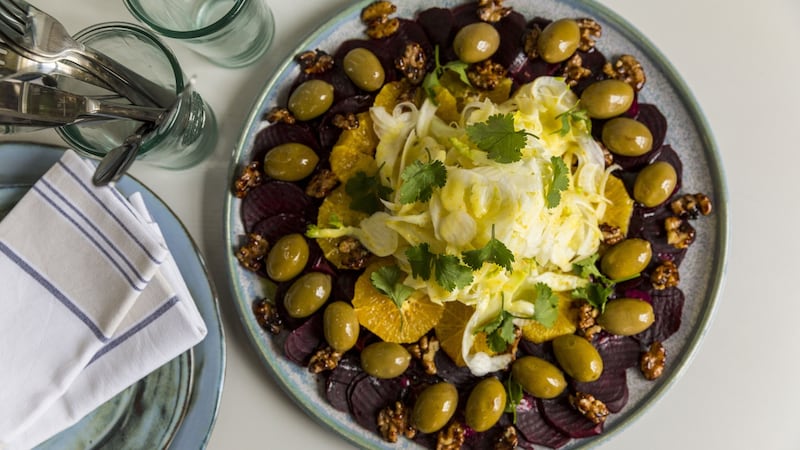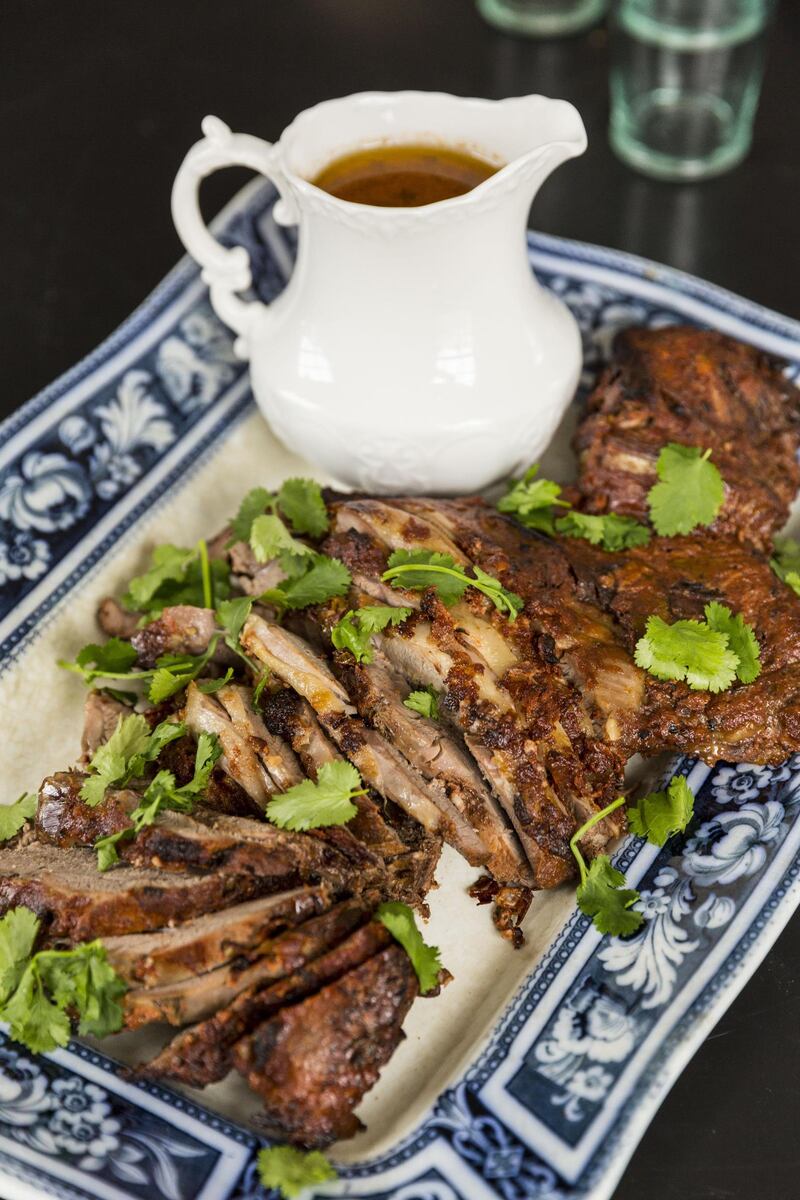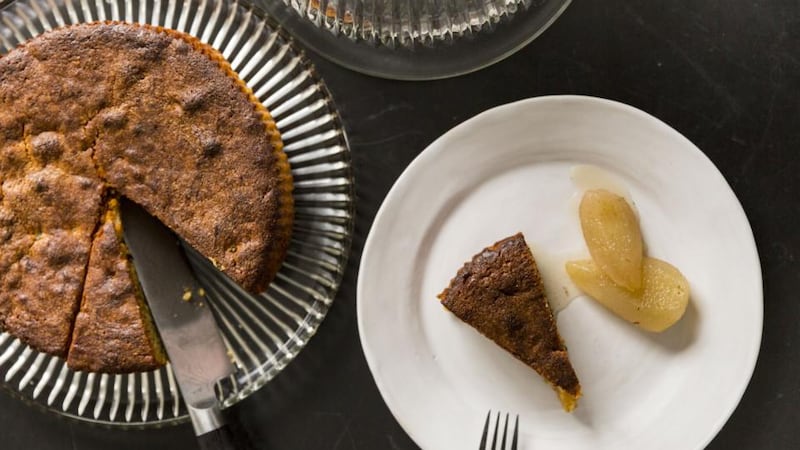This must be one of the most exciting weeks of the year. Spring is in the air, the evenings are longer, the prospect of a holiday lies ahead and only one week remains of Lent – which is always followed by a reward and a promise of a special roast lunch.
There is something both challenging and rewarding about cooking at this time of year. We still have a little winter produce around, bits and pieces in our cupboards to use up, and, if we are lucky enough, we might just get a glimpse of some of the new season’s produce.
This week’s recipes make it easier to bridge the seasonal gap for your Easter roast. The lamb dish works with whichever cut you fancy, whether leg or shoulder.

Salad of beetroot, oranges, fennel, olives, pomegranate and walnuts
This is a salad that uses up what's left of the winter season and some store-cupboard staples.
Serves 4
4 medium beetroots
2 oranges
1 large fennel bulb
12 olives of your choice
Pomegranate seeds
Olive oil
16 walnuts
Fine salt
1 head of endive
For the dressing
Zest and juice of a large orange
Zest and juice of a small lemon
Olive oil
Salt and pepper
Heat the oven to 200 Celsius. Wash the beetroots well, dry and rub each with a little olive oil. Put them in an ovenproof saucepan with a tight-fitting lid and bake until the beetroots are soft through when pierced with a sharp knife – about 40 minutes. Allow to cool.
In the meantime, slice the fennel as thinly as possible. Remove the seeds from half a pomegranate and remove the skin and pith from the oranges and thinly slice the flesh.
Mix the nuts in a bowl with just enough oil to coat them evenly, and season generously with salt and, if it’s your thing, a little chilli.
Make the dressing by chopping the orange and lemon zest very finely and mixing it with the juice and a little salt. Blend really well in a food processor or liquidiser. Next add a drizzle of oil and blend again. Now start tasting, and keep adding oil and salt until you really like the balance and taste of the dressing. Then add a few grinds of black pepper and give it another blending, followed by a final tasting, to make sure you are happy with it. It needs to be sharp and catch you slightly at the back of your mouth.
Finally, take a big serving dish, peel and slice the beets and arrange to your liking, followed by the oranges and fennel, and finish off with the olives, pomegranates and walnuts. Now scatter the leaves of the endive on top.
Pour the dressing over the dish just before serving.

Ottoman baked lamb with aubergine bechamel
This is a great dish adapted from Jeremy Round's book The Independent Cook. I have altered it to work with both leg and shoulder. I find that a shoulder works best with slow baking; a leg needs fast, high heat to get the best results. You'll find methods for both cuts below.
Serves 6
300ml natural yogurt
4tbsp tomato puree
½ cup red wine
¼ cup olive oil
6 big garlic cloves, crushed
2 dry bay leaves, crushed
2 sprigs of fresh thyme
1tsp salt
1tsp ground black pepper
About 3kg shoulder of lamb or leg of lamb, trimmed of excess fat and main bones removed
Start this the night before by marinating the lamb. In a large stainless-steel bowl beat the yogurt with the tomato puree. Continue beating as you dribble in the olive oil and wine. Mix in the garlic, bay, thyme, salt and pepper. Make deep incisions all over the lamb and then put it in the marinade, rubbing the marinade all over the meat. Cover and turn occasionally.
For lamb shoulder The next day heat the oven to 180 Celsius. Take the lamb out of the marinade (keep any excess for later) and place in a roasting tin. Cover with parchment or foil and bake for two hours. Take the meat out of the oven, then pour the juices into the reserved marinade and keep for later. Remove the cover and put the meat directly on the oven rack, with the tin on the shelf beneath, to catch the dripping juices, and cook for another 45 minutes.
For leg of lamb Heat the oven to 225 Celsius. Place the lamb on a roasting tray (do not cover) and roast for 40 minutes. Then remove the meat from the tray and put it directly on the oven rack, turning it the other way around. Place the tray underneath, to catch the dripping juices, and cook for another 15 minutes.
Remove whichever lamb cut you’re using from the oven and allow to stand in a warm place for 20 minutes before carving.
In the meantime pour a cup of water into the roasting tray and put over a medium heat to clean the pan. Add this liquid to the reserved juices and marinade and reduce the lot in a small saucepan until you are happy with the flavour.
Carve the meat into thick slices and arrange on a serving platter on top of the aubergine bechamel, and pour the reduced roasting juices over.
For the aubergine bechamel
You'll find yourself licking your fingers with this sauce. It's great for vegetarians when served with some roasted vegetables. It can be made in advance and reheated when needed, and any leftovers will keep for a few days in the fridge.
1.5kg aubergines
50g butter
50g flour
salt
400ml milk, boiling
50g Cheddar, grated
Roast the whole aubergines in a very hot oven until they are soft and charred all over.
When cooled, peel under running water and squeeze well, to get out as much liquid as you can. Mash the aubergines with a fork or in a food processor.
Next melt the butter in a medium saucepan, add the flour and a pinch of salt, and cook together for a minute, until the flour is pale and sandy. Then pour in the boiling milk, all at once, and whisk until the sauce is smooth and thick. Cook for a couple of minutes, stirring well.
Stir in the aubergine puree and allow to heat through, then stir in the cheese. When it has melted, taste and add more salt if needed.

Orange, almond, ginger, sour cherry and bitter chocolate cake
This is a flourless cake that isn't too heavy and also has chocolate. Often I skip the syrup out of laziness and have a lighter cake, especially if I am serving it with fruit in syrup. This is inspired by Willie Harcourt-Cooze's chocolate book. It can also be made well in advance, to ease time strain on the day.
Serves 8-10
200g soft butter
200g sugar
250g ground almonds
3 eggs
Grated zest of 3 oranges
Juice of ½ orange
75g medium-ground polenta
½tsp baking powder
½tsp cream of tartar
50g dried sour cherries or cranberries
60g chopped ginger, preserved in syrup
80g of your best chocolate (chopped)
Syrup
Juice of 2 oranges
3tbsp ginger syrup
Preheat the oven to 160 Celsius. Line a 28cm cake tin with parchment and oil.
Beat the butter and sugar together until light and fluffy. Add the ground almonds and beat in the eggs one at a time. Mix in the zest and juice and fold in the polenta, baking powder and cream of tartar. Then mix in the sour cherries, ginger and chocolate.
Put the mixture into the prepared tin and bake in the preheated oven for about 40 minutes.
Take the cake out of the oven and leave it to cool in the tin. Then turn it on to a plate.
Make the syrup by boiling the orange juice with the ginger syrup until reduced to a thick syrup.
While the syrup is still hot, brush it over the cake and allow to cool.
Serve with pears in vanilla syrup (recipe below).
Poached pears in vanilla syrup
I find Conference pears the best all-rounder; they're easy to ripen and don't bruise as easily as other varieties. You want your pears to be a little on the unripe side for this dish. These pears are also ideal for breakfast or served with cream and toasted flaked almonds or pine nuts for lunch or dinner. They are also good keepers, so can be made a few days in advance – the flavour will also benefit.
Serves 8
8 pears, peeled, cored and halved
400g sugar
500ml water
2 vanilla pods, split and scraped
Put the sugar, water and vanilla pods in a saucepan and bring slowly to a bubble, stirring until the sugar dissolves, and boil for just two minutes.
Then add the pears and poach until soft – about 15 minutes – before allowing them to macerate for several hours.








